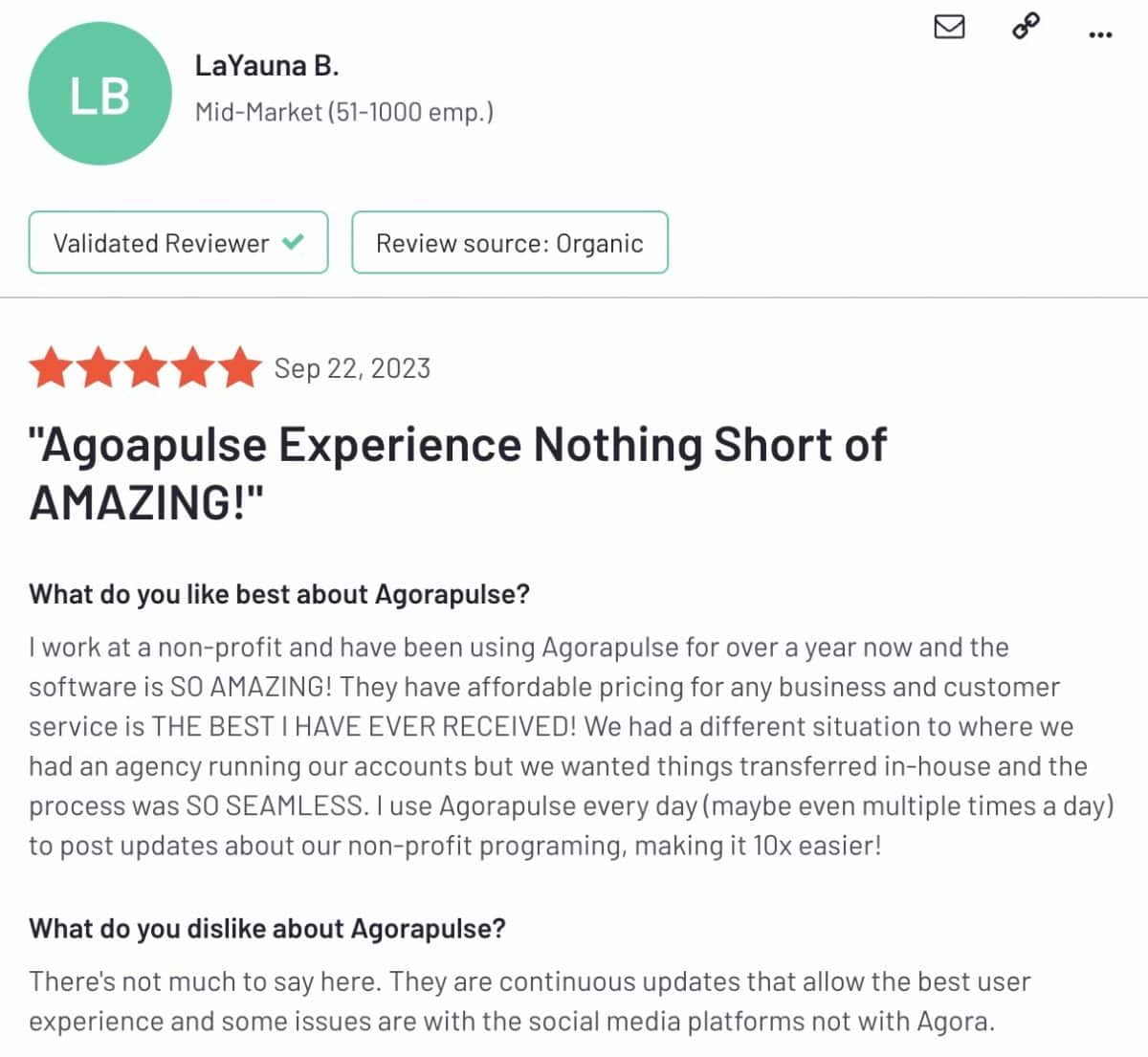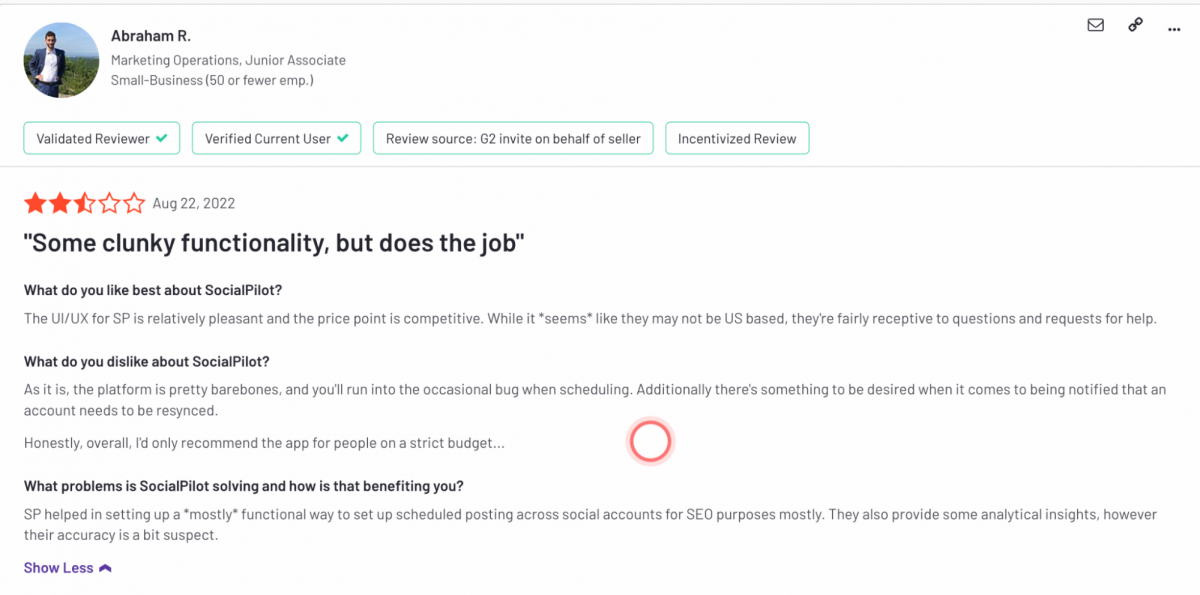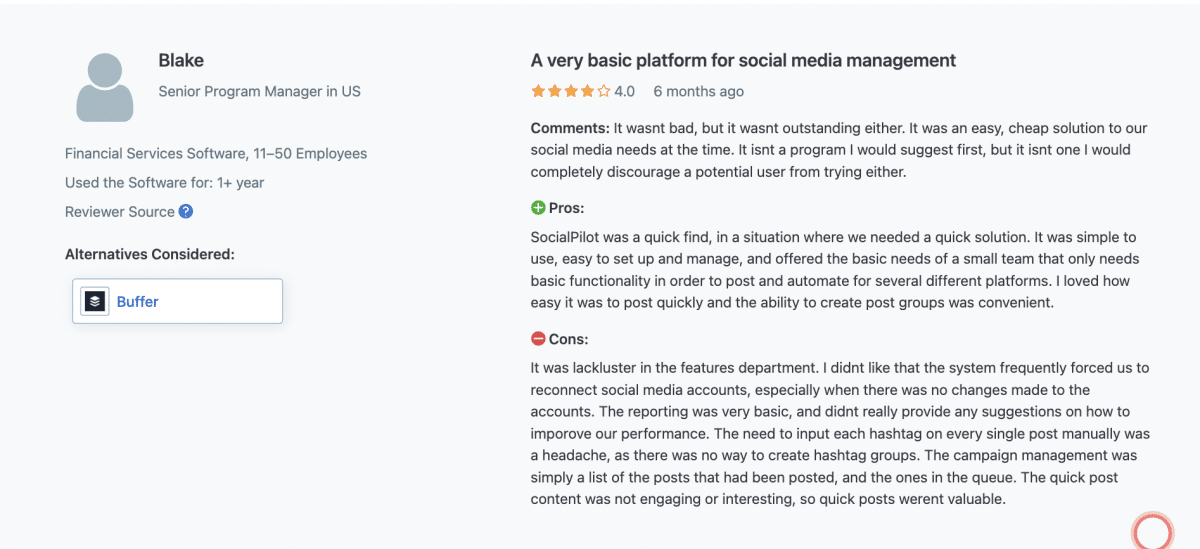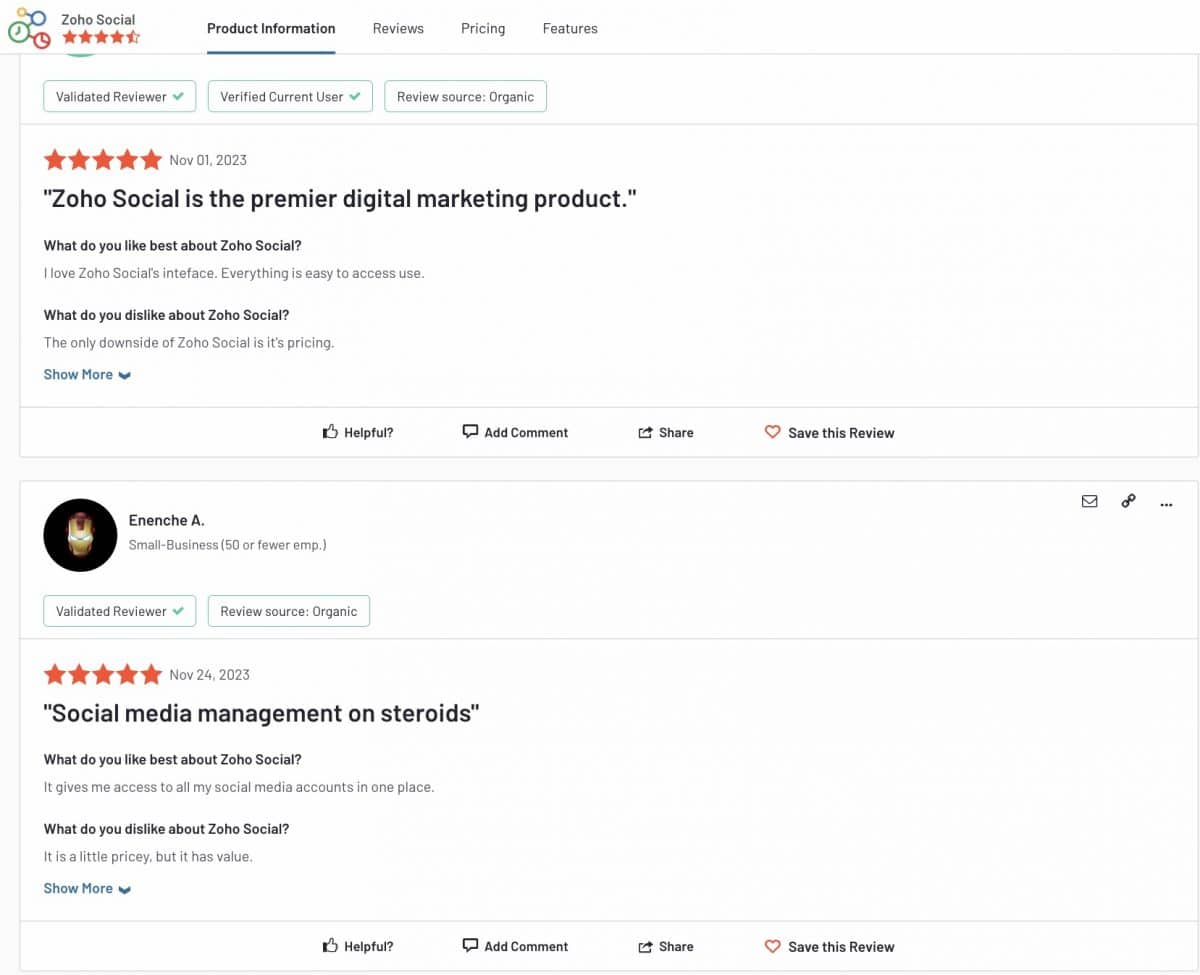You may think that Buffer is your go-to for social media management, but is it really the best you can do? That’s what you are about to find out. We’re going to take an in-depth look at three of the most underrated Buffer alternatives on the market: Agorapulse, SocialPilot, and Zoho Social. Read on as we dig into the features and pricing of these tools, and most importantly, find out whether they can go toe to toe with Buffer.
Basics of Buffer
Buffer at a glance
Social networks supported: Facebook, Instagram, TikTok, LinkedIn, X (formerly known as Twitter), Google Business, YouTube, Mastodon, Shopify, and Pinterest
Free plan available: Yes
G2 rating: 4.3 / 5
Before looking at the alternatives to Buffer, we should probably take a minute to talk about Buffer itself. That way, when the time comes to choose your social media management tool, you have all the details needed to make an informed decision.
So here’s a bit of background on Buffer:
Buffer is a well-known player in the social media management space, lauded for its intuitive and straightforward software. Since its inception in 2010, Buffer has expanded its horizons, evolving from a tool that was focused just on scheduling tweets, to a more comprehensive social media management platform.
The Buffer of today includes many other useful functionalities like basic post analytics, scheduling and publishing features for multiple platforms, and also includes many integrations with other popular tools. This expansion reflects an understanding of the evolving needs of its core user base: small businesses, creators, and individuals.
However, no tool is one-size-fits-all. Some businesses may find that Buffer doesn’t meet their needs completely.
Buffer users may seek alternatives for a number of different reasons. Price is a frequent factor. Buffer’s pricing structure might not be right for every budget. As you’ll see from this article, the price isn’t always the best value for your money compared to other similar tools.
Additionally, while Buffer excels in simplicity, some businesses may find they need more advanced features and functions, particularly as their business begins to grow. For example, marketing agencies that are seeking rapid growth, often look for Buffer alternatives once they realize they need more in-depth analytics, social listening, or enhanced team collaboration tools.
Lastly, the user interface, though being user-friendly, might not resonate with everyone’s taste or workflow preferences, prompting search for alternatives that feel more tailor-made or include options for white-labeling.
This also brings up a pretty important question: What features should you be looking for in a social media management tool?
Free Checklist: Do You Need to Change Your Social Media Management Tool?
Buffer Alternatives: Features to Look for
When you are searching for alternatives to Buffer, there are several key features that you should look for:
Scheduling
The backbone of any social media tool, scheduling allows for the planning and automatic posting of content across different platforms. This feature saves time and ensures consistent online presence, even outside business hours.
Advanced analytics
Understanding how your content performs is crucial. Analytics provide insights into engagement rates, audience demographics, and the overall impact of your social media campaigns. These data points guide strategy adjustments for better performance.
Team collaboration
Social media management often involves multiple team members. Collaboration features enable teams to work together seamlessly, share feedback, approve posts, and manage multiple accounts without stepping on each other’s toes.
Inbox management
Managing incoming messages, comments, and mentions in one place prevents important interactions from slipping through the cracks. Effective social media management tools will have social media inbox capabilities built right into the platform to help maintain timely and organized communication with your audience.
These features are integral to building a robust and responsive social media strategy. They allow for efficient management, informed decision-making, and ultimately will help you build a strong and trusted brand on social media.
Now, with that in mind, let’s take a look at our favorite Buffer alternative out there: Agorapulse. (Yes, we’re a little biased … but not without good reasons to be.)
Buffer Alternative #1: Agorapulse
Agorapulse at a glance
Social networks supported: Facebook, Instagram, TikTok, LinkedIn, X (Twitter), Google Business, Youtube, and Pinterest
Free plan available: Yes
G2 rating: 4.5/5
Buffer has established itself as a staple in the social media management tool arena, but Agorapulse is a formidable alternative that offers a suite of features that outperform Buffer in several aspects.
Sign up now for a FREE trial of Agorapulse.
Why Agorapulse Is the Best Buffer Alternative
There are many reasons to choose Agorapulse instead of Buffer. Here’s some of the biggest ones:
Social Media Inbox
Agorapulse’s unified Social Media Inbox is a significant advantage over Buffer due to its comprehensive inbox management features. There isn’t something really comparable to this in Buffer. The closest comparable feature, if you can even call it that, is “Buffer Engage.”
However, Buffer Engage has very limited support for platforms, and includes just Facebook profiles and Instagram business pages. It also lacks many of the time-saving features you’d find in Agorapulse, such as saved replies, labels, and notes. The Advanced and Custom plans also include the Inbox Assistant, which allows you to automate tasks like reviewing, deleting, or assigning inbox items based on certain keywords.
(It should be noted that Buffer actually used to have a much more advanced social media inbox called Buffer Reply. But strangely enough, this feature was discontinued back in 2020 and hasn’t been replaced by something that is equally capable.)
Advanced analytics
While both platforms do offer analytics, Agorapulse provides more in-depth data and better visual reporting, which is crucial for analyzing the effectiveness of social media strategies. At least, that is according to hundreds of reviews on G2, which overall rated Agorapulse’s analytics at 8.8, whereas Buffer was rated at just 7.8 in the same category.
Social listening
Agorapulse’s social listening tools give you the ability to track and analyze conversations about your brand or industry across social media. This is a big differentiator between the two platforms, as Buffer has no social listening capabilities at all. Enough said.
Built-in CRM
Similarly, the incredibly useful CRM feature in Agorapulse is noticeably absent in Buffer. And for businesses looking to grow their audience, this critical missing feature can slow down your progress.
Without a built-in CRM, management of engagement can rapidly evolve into an overwhelming task, or one that perpetually sits on the back burner. This makes Agorapulse a better choice for businesses focused on relationship building and follower management.
For many users, one of the most important deciding factors is the price of the tool. And this is yet another area where Agorapulse provides a great value for money in comparison to Buffer.
Although Buffer’s plan seems “cheaper” on the surface, when you look a bit closer, you see that Buffer does not include nearly as many features as you get with Agorapulse. And if you are going to be adding 10 social accounts or more, the monthly cost difference between Buffer and Agorapulse is negligible.
Check out an in-depth review of Buffer Pricing.
Lastly, let’s take a look at how the two platforms are rated by users on G2 and Capterra in key areas like product direction, and quality of support. As seen below, Agorapulse is the clear winner in this regard.
This is also supported by reading the many reviews praising Agorapulse for its excellent customer support (which is available 24/7, in case you were wondering.)
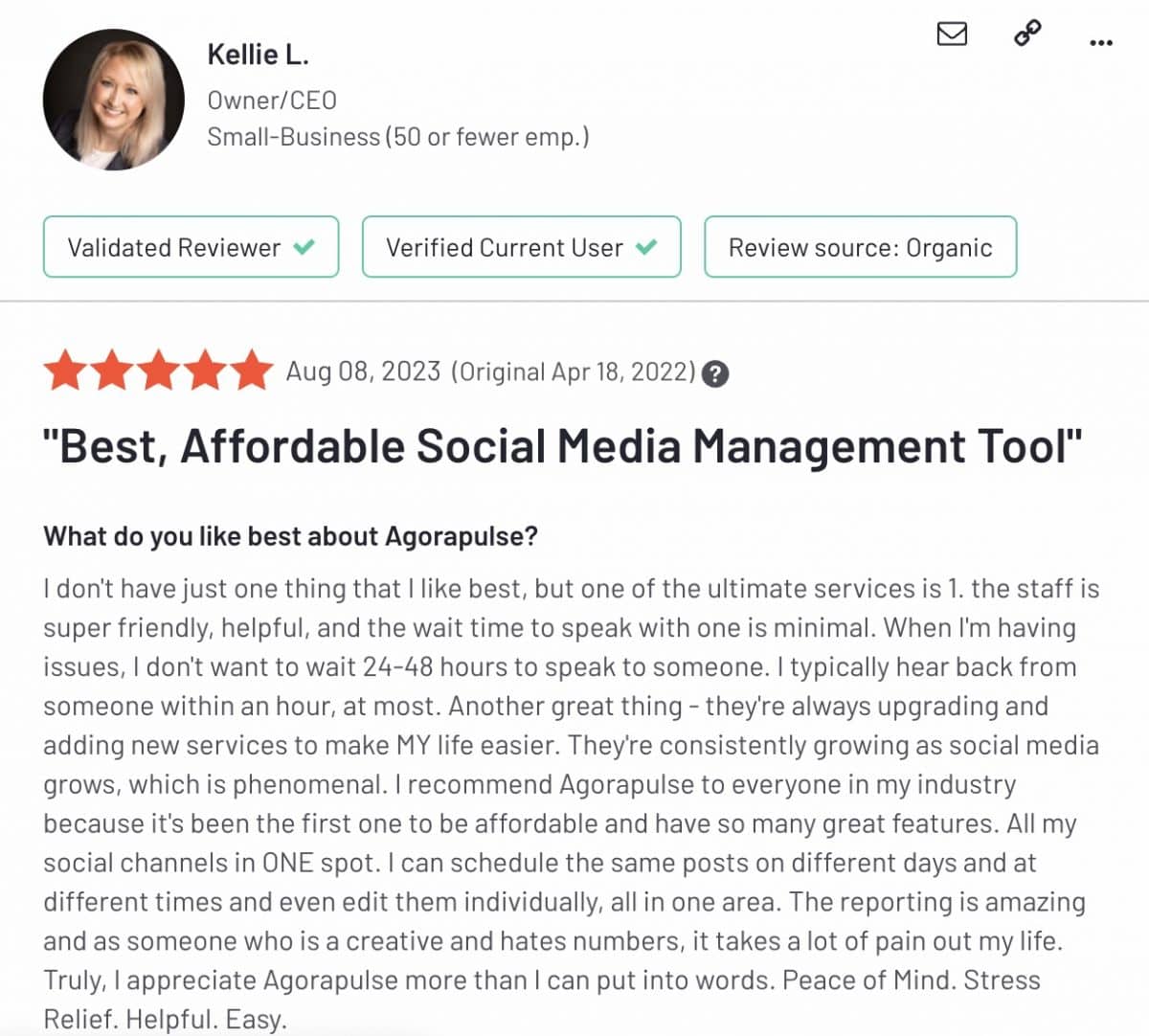
Agorapulse review from Sept 2023 on G2
Overall, Agorapulse is the more feature-rich and versatile tool compared to Buffer, especially for medium to large-sized businesses, or agencies that require an all-in-one solution for their social media management. The platform’s emphasis on engagement, analytics, listening, and built-in CRM make it a clear winner when it comes to choosing a Buffer alternative.
Get our FREE the Social Media Management Tool Comparison Workbook
Buffer Alternative #2: SocialPilot
SocialPilot at a glance
Social networks supported:Facebook, Instagram, TikTok, LinkedIn, X (Twitter), Google Business, YouTube, and Pinterest
Free plan available: No
G2 rating: 4.5/5
Next up for you to consider as a Buffer alternative is SocialPilot.
SocialPilot is a fairly comprehensive social media management tool that caters primarily to small businesses. The platform offers many features for social media management that can rival Buffer in both efficiency and cost.
Here are some of the standout features in SocialPilot:
Inbox management: SocialPilot gives you an integrated inbox to manage all social media interactions in one place, saving time and ensuring no message is lost in the shuffle.
Bulk scheduling: SocialPilot allows scheduling up to 500 posts at once, a feature that is immensely useful for planning campaigns in advance and saving time. Currently, bulk scheduling is not available with Buffer, although it has been suggested to their product team, so something could be in the works in the future.
Team features: Similar to Buffer, SocialPilot offers basic team management options, where you can set specific roles and permissions for team members. However, you’ll find that the capabilities for team management are more advanced in Agorapulse.
Analytics: SocialPilot’s analytics includes reports that can be branded for client presentation, something not all Buffer plans provide.
Content discovery: SocialPilot provides tools to discover trending content, helping you keep your social media feeds active and engaging without spending hours on content research.
Besides features, one of the biggest benefits of using SocialPilot is simply the fact that the price is pretty reasonable, as is noted in several G2 and Capterra reviews.
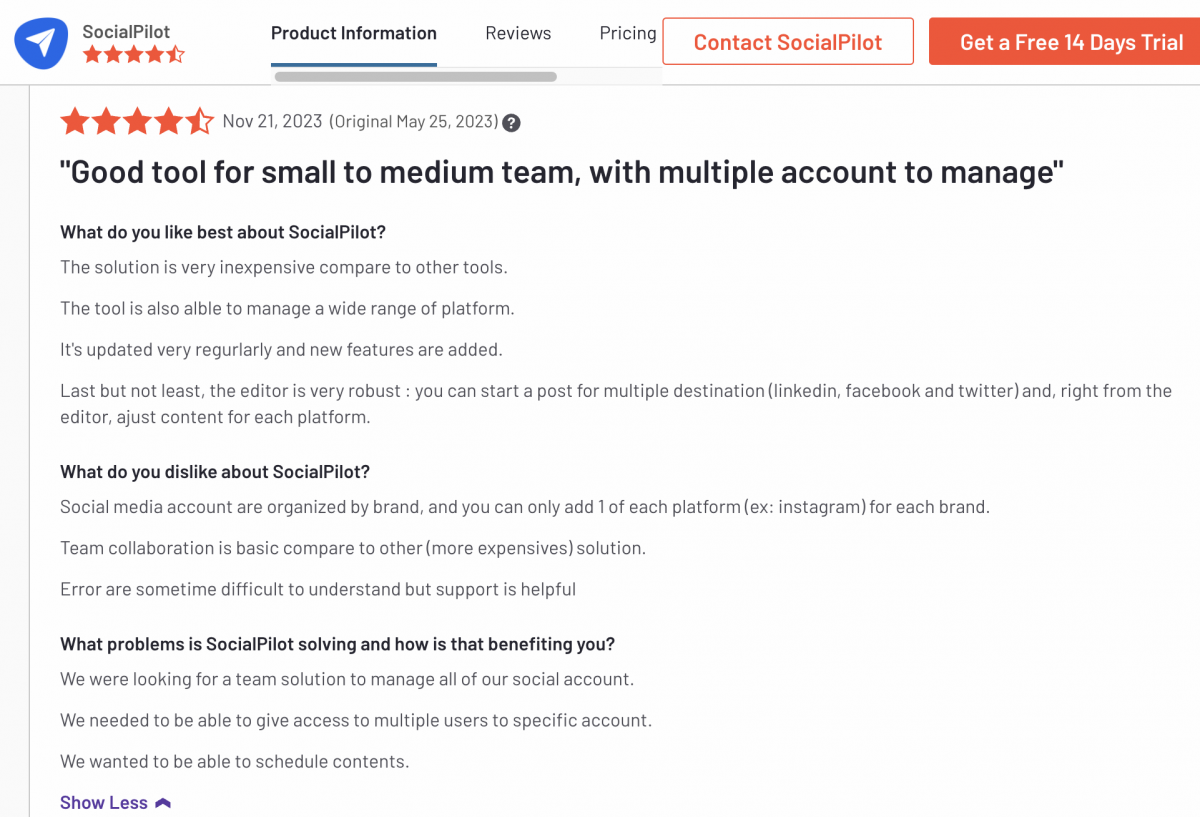
G2 review of SocialPilot
Let’s take a quick look at the SocialPilot pricing plans available:
Professional: For individuals or small businesses, it’s $30/month or $22.50/month paid annually, offering 10 social media accounts and 1 user.
Small Team: $50/month billed monthly or $37.50/month paid annually. You get 20 social media accounts and can add up to 3 team members, suitable for small businesses or teams.
Agency: $100/month for monthly billing or $75/month when billed annually. This plan includes 30 social media accounts and 6 users, perfect for growing teams with extensive social media needs.
Agency+: $200/month or $150/month paid annually. You can connect up to 50 social media accounts and an unlimited number of users on this plan. So, it’s ideal for large enterprise teams needing significant account management.
When compared to the price of Buffer, SocialPilot provides a more flexible and value-oriented structure. The Agency+ plan at SocialPilot offers significant cost savings over time compared to Buffer’s similar tier plan. With the additional features like the social inbox and content curation, SocialPilot offers a well-rounded package for basic social media management.
The trade-off with having such a cost effective platform though, is that it may cost you more time and money in the long run. For example, Some users on G2 have mentioned SocialPilot has had issues with reliability in posting, and you may encounter the occasional bug.
And it should be noted that while SocialPilot has made significant strides in regards to features, there definitely still is room for improvement in terms of its analytics and reporting. At least according to some user reviews found on G2.
G2 user review of SocialPilot
Overall, both Buffer and SocialPilot have their merits, and for a business that requires basic social media management capabilities, SocialPilot certainly presents itself as a strong Buffer alternative. It provides many features which cater to a range of social media management needs, without a steep learning curve, and at a price point that is hard to beat. This makes SocialPilot a practical choice for budget-conscious businesses.
However, for brands looking for more advanced features such as social listening, they may want to consider other alternatives like Agorapulse or Zoho Social. Which leads us to the next Buffer alternative on our list.
Buffer Alternative #3: Zoho Social
Zoho Social at a glance
Social networks supported: Facebook, Instagram, LinkedIn, X (Twitter), Google Business, Youtube, Pinterest, Mastodon
Free plan available: Yes
G2 rating: 4.6/5
Zoho Social is recognized as a highly capable Buffer alternative, particularly for businesses and agencies seeking an expansive suite of social media management tools. However, it also has its drawbacks. A big one for many brands is the fact it does not support TikTok. (Other similarly priced Buffer alternatives like Agorapulse do allow you to publish to TikTok.)
Features of Zoho Social
Zoho Social is lauded for features like post recycling, bulk scheduling. Similar to Agorapulse, it includes a social inbox that consolidates messages from different platforms for easier engagement.
Additionally, Zoho Social offers capabilities such as X/Twitter thread scheduling and the ability to auto post from RSS feeds, neither of which are available in Buffer.
Zoho Social also integrates smoothly with other Zoho products, like Zoho CRM, which works well for businesses looking to have a synchronized customer relationship and social media strategy.
Cost of Zoho Social
In terms of pricing plans, Zoho Social offers five different options, Standard, Professional, Premium, Agency, and Agency+.
Here’s a quick breakdown of each:
Standard Plan: This plan starts at $10/month paid annually, or $15/month for monthly billing. In contrast, the comparable Buffer Essentials plan starts at $6/month, per channel. This would make Buffer quite a bit more expensive if you needed to connect many accounts. On the plus side, this Buffer plan has unlimited users (whereas the Zoho Social plan includes just one user account).
Professional Plan: Priced at $30/month annually this plan includes many more features like live streaming on supported channels, the ability to create custom video thumbnails, RSS feeds, and access to a content library. Notably missing though from the Professional Plan is the social inbox, a critical feature that you certainly don’t want to go without. But this isn’t available unless you are bumped up to the next pricing tier.
Premium Plan: This is the mid-range pricing tier of the Zoho Social plans, and it starts at $40/month annually, or for monthly billing it is $60/month. This plan does include important features such as a central inbox, integrations with Zoho Desk and Zoho CRM, as well as the ability to create custom roles.
Agency Plan: This plan is fairly self-explanatory. As the name would suggest, this plan is tailored for marketing agencies, and starts at $230/month paid annually, or $320/month for monthly billing. This includes up to 10 brands, 5 user accounts, and comes with all the bells and whistles that Zoho has to offer.
Agency+ Plan: This is essentially the same as their Agency Plan, but you get 20 brands, instead of 10. The cost for this plan starts at $330/month annually, or $460 when paid monthly. It still comes with just 5 user accounts though. Compared to the unlimited team user accounts with Buffer, this may be kind of a bummer. (You can add additional accounts for your team, but it comes at an additional cost of $12/person/month.)
What do G2 reviews have to say about the cost of Zoho? Well, some users felt that even though they like the platform, they really didn’t like the price tag of it.
Zoho Social’s broad feature set, coupled with the ability to integrate with other Zoho services, presents it as a strong contender for businesses that are serious about social media management. Its focus on efficiency and team collaboration makes it a good choice to be considered for those who find Buffer’s offerings limited (as long as you have got the budget to afford it).
Popular Buffer Alternatives That Didn’t Quite Make The List
Sprout Social
While Sprout Social is an advanced and capable platform, its exorbitant pricing makes it out of reach for many businesses. And for the brands that can afford the cost of Sprout Social, they often find their needs can be served just as well (or even better) with tools like Agorapulse. Additionally, the platform can be confusing, and isn’t very intuitive for new users, making it difficult for some businesses to use effectively.
Brandwatch
Although Brandwatch offers many unique features, they aren’t ones that are a necessity to a social media management platform. And the platform caters primarily to enterprise businesses. Buffer primarily serves small businesses, so although Brandwatch is a highly advanced platform, it’s just not a great Buffer alternative.
Hootsuite
In spite of Hootsuite’s long-time position as leader of the social media management industry, it didn’t quite make our list. This is due to the simple fact that in recent years, the platform’s growth has plateaued, and its features and capabilities seem to have done the same. The stagnant Hootsuite platform has not evolved along with the rapidly changing industry, leaving its users with a tool that isn’t as capable as others out there, but yet still comes with the hefty price tag.
Which Buffer Alternative Will You Choose?
Each of these highlighted platforms have their pros and cons.
Choosing the right social media management platform for you will ultimately come down to what your business goals and objectives are. Ideally, you want to find a tool that will make reaching those goals a whole lot easier.
And for many brands looking to grow on social media, Agorapulse is the right tool to do just that. With features that go beyond the basics, Agorapulse cuts down on the tedious, repetitive tasks, giving you the time to focus more on strategy—and less on scheduling. Find out what you’ve been missing with a free trial of Agorapulse today.






